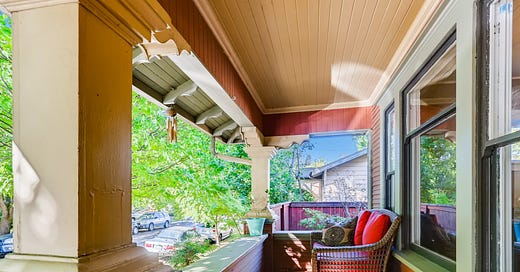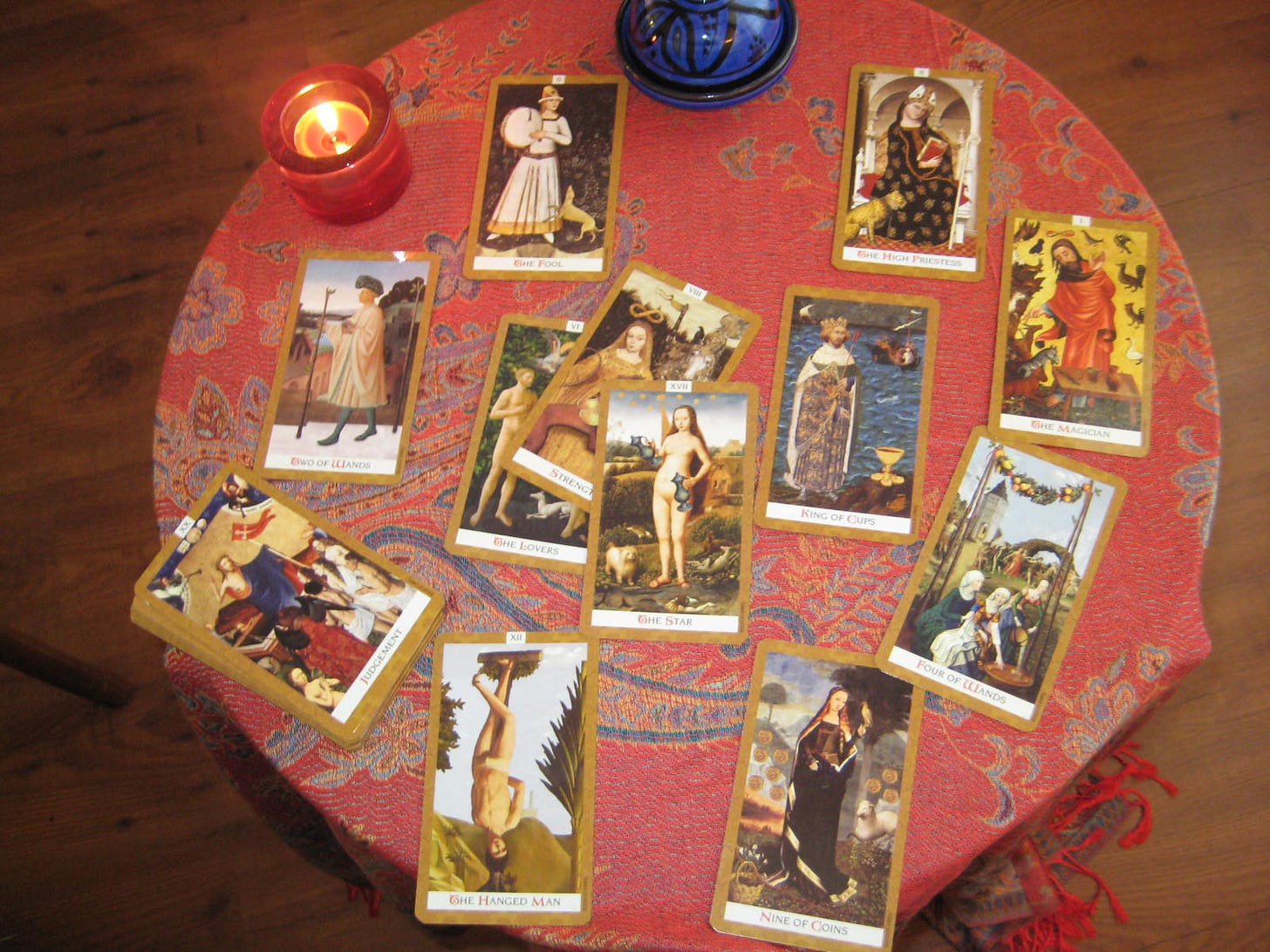Confessions of a Porch Spy
A porch is an excellent space for drinking in street scenes without being observed. Just don't write an article about it or you'll ruin the magic.
Every country has its special spaces to see and be seen — Italy with its fountained piazzas, Spain with its terrace bars, France with its ubiquitous sidewalk cafés — but for nearly a century in the US, the favorite spot for people-watching was the front porch, an entirely American invention that’s now mostly cast aside.
The architectural trend took off in the 1850s providing a covered, breezy spot for keeping up with the neighbors while socializing with family and friends when weather was warm as well as a place to leave wet umbrellas and muddy shoes when it wasn’t.
However, by the 1930s, when families turned to living rooms and gathered around “the wireless” — while the former pedestrians who once strolled past homes now zipped by in cars — architects began dismissing porches as old-fashioned and useless.
Instead, Americans looked behind them — and began building patios in the backyard, festive sites for kiddie pools, grills, and barbeques, but a design innovation that cut connections with street and community.
Nevertheless, in some towns filled with historic homes, porch culture never disappeared — among them, Savannah, Georgia, where late afternoon lemonade, mint juleps, and potent punches are served on oft-used grand verandas looking onto trees dripping with Spanish moss.
But to my mind, Portland, Oregon has the world’s finest porches, especially those sweeping affairs that spread out from old Victorian homes in the city’s northwest neighborhood known as Nob Hill.
Not entirely outside or in, these in-between spaces are the perfect places for spying on the ground-level parade passing by. And I did.
On Portland’s well-traveled NW Northrup Street, which led to a hospital and to the hipster-filled 50s-style diner Quality Pie, skateboarders roared down the street’s incline at high speeds, aiming for the uplifted piece of sidewalk just in front of my porch, transforming concrete imperfection into a ramp for their jumps.
The neighborhood was choc-a-bloc with homes for the mentally challenged whose residents brought many layers of audial color as they strolled past holding heated conversations, talking alone to themselves. At precisely 3:47 each afternoon, the hunched-over old lady with Tourette’s Syndrome hobbled by, each day unleashing a slew of obscenities that could make sailors blush.

Around 7:15, a white-smocked doctor with a pronounced limp returned to his car in the across-the-street lot, his mood always somber. How many people had died before him that day, I often wondered, how many times had he delivered bad news?
And whatever the hour or day, small crowds — young families, silver-haired couples, stoned teens — gathered in front of the windows of the Quality Pie bakery, hypnotized. Just beyond the glass was an automated conveyer belt contraption called “The Donut Robot” that punched circles out of the dough, then dropped the blobs into bubbling grease, from which the now perfectly golden donuts were pushed out, some moving down to be sprinkled with sugar, others automatically iced.
I spent hours every day observing the lively street happenings that unfolded just before me, ultimately dragging out my typewriter and turning the porch into my outdoor office in all but the chilliest months.
When I wrote an article about my special space for Willamette Week, however, I inadvertently shattered that world.
Shortly after the appearance of my article, titled “Porch Potato,” the skateboarders stopped clacking down Northrup and the upthrust flaw on the sidewalk was fixed. The obscenity-screaming old woman no longer appeared nor did her self-conversational cohorts; the somber doctor with a limp apparently changed parking lots.
But the most horrifying ramification of my published porch musings was what happened at Quality Pie, whose donut-making display I’d labeled “Portland’s best sidewalk entertainment.” I added, snarkily, that the view wasn’t quite as compelling toward the end of the month, when the bubbling donut grease looked kinda grody.
In response, Quality Pie papered over their bakery windows, blocking the view of their beloved donut-frying machine — and they kept up the paper for months. I felt guilty every time I trudged by, all the more when the diner closed the next year.
While never writing again about a veranda, lest I once again killed the magic, I set up office on other Portland porches, including that of the 3-story Victorian called “Hell Cow House,” because it housed the same-named punk band. The coolest thing about the rambling abode, besides the porch, was that Katherine Dunn, author of Geek Love, lived right next door, and would often stop for a chat on our porch. She even wrote a short story about it.
In Katherine Dunn’s tale, a mysterious writer appears on a porch with her typewriter every evening — intently observing the racing police cars, the drug deals, and the knifings, then typing madly on her typewriter late into the night. At the story’s end it’s revealed that she’s writing about a cow flicking its tail amid bucolic bliss.

I later took an apartment around the corner on NW Johnson Street, which lacked a porch but did have a gated patio — an experience which quickly illustrated the difference between the two.
I pulled out a table on the patio, covering it with an exotic tablecloth and illuminating it with a gold-glowing paper lamp, creating a vaguely tiki-ish effect, and invited friends over for wine and tarot card readings.
But unlike a porch, which is usually elevated and set further back from the sidewalk, the patio seemed to hold up a welcome sign to the general public. Every night a stranger or two walked through the gate, took a chair on my patio, ordering a drink and asking the price for card readings.
I started throwing dinner parties on the patio, but these, too, proved problematic — and not just because the Jim Rose Circus Sideshow began performing in Portland, and detailed descriptions of Mr. Lifto and exactly what he hoisted with his 13 pierced body parts and how they stretched out when he did — which was all that anybody could talk about that summer — was enough to kill the heartiest appetites.
Another woe: audial disharmony. A halfway house sat across the street, and just around dinner-party time, the residents would pour onto their porch and launch into high-decibel diatribes— a phenomenon known in the neighborhood as their “summer lecture series.”
Worse, the upstairs neighbors had a balcony, which jutted out, covering half of my ground-level patio, and the couple often parked their dog there right overhead. Some nights he’d go off on a barking fits, other nights whining fits, and one memorable evening, just as I presented a heaping bowl of fabulous pasta, the dog profusely drooled all over it, the saliva stream cascading from six feet above.
Shortly thereafter I left Portland, always seeking a place with a porch looking onto a lively street, and never again finding one.
However, in Seattle, then Barcelona, Thailand, and Croatia, I moved up in the world — and onto balconies. And those perches — that are likewise neither fully outside nor in — lent themselves to far wilder sights and stories…
To be continued with the upcoming post “Balcony Bliss.”








I will write an essay about my porch experience and share it with you… As ever, your writing has that quality that “takes you there.” 🍾
Lovely writing, as usual, Melissa. You suddenly awaken my cravings for a cool mint julep. I would love to enjoy a stay in Savannah! You made it so appealing... With all due respect for dog owners, and I have been one, these mascots are not for living in close quarters but in open spaces, where they can run free with other doggies. Those episodes of barking, whining, and drooling you funnily described, what could I say? It should be regulated by law! However, since cats and dogs are the present substitutes for children in countries with low birth rates, that's impossible.